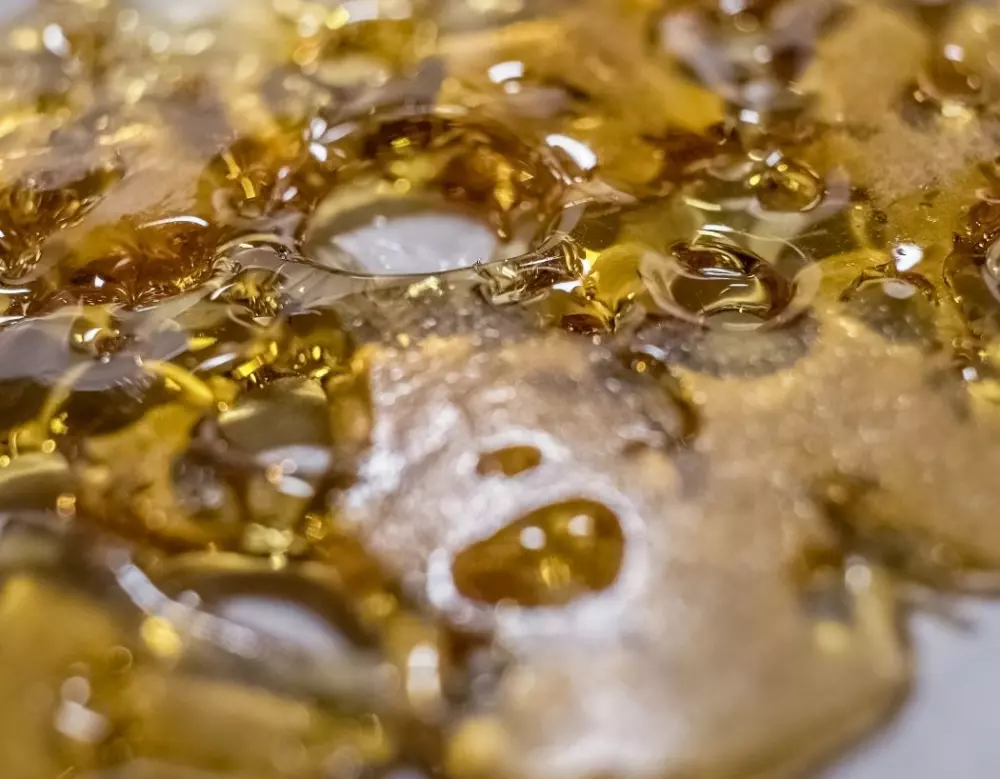Shatter is one of the many popular types of cannabis concentrate, falling under the sub-category of butane hash oil (BHO). It is extracted from the cannabis flower by using butane, or in rare cases, another chemical solvent, like ethanol or liquid CO2.
It owes its hardness and brittleness (hence the name, 'shatter') to slight differences in the manufacturing process, which we'll discuss in a bit. Like all other chemically
extracted concentrates, its THC content can be as high as 85% and it's most commonly dabbed in a dab rig.
What is shatter best used for?
Shatter is most often vaporized by dabbing. Just like other low-temperature extracts, it contains a high percentage of THCA, which is actually part of the reason why it can be so hard and brittle. THCA is a THC precursor and it turns into THC after being heated to around 220 for 30-40 minutes.
The typical vaping temperatures of around 400 are enough to transform all of the THCA into THC in a matter of seconds. This process is called decarboxylation and is well known to people who've made edibles before.
As is the case with all cannabis-derived products, shatter can also be made from a high-CBD, low-THC plant. As you well know, CBD doesn't get you 'high' and is usually used for its medicinal and anxiety-relieving properties.
How is shatter manufactured?
The most common solvent used in the extraction process of shatter is butane. Under high pressures, liquid butane passes through a column, packed with the plant material and dissolves most of the active compounds we are interested in.
After that, the resulting goo is put in a vacuum chamber, where slight heat is applied. This is called purging, and while most concentrates are purged at around 120, shatter is typically heated to no higher than around 100, which contributes to its brittleness and translucence.
Shatter can be produced from high-potency flower material but is often extracted from the lower potency leftovers, such as the trim or shake. That's because the higher potency material obviously has other uses and can be directly sold to consumers, made into
kief and hash, and so on.
Why is shatter harder and more brittle compared to other concentrates?
In reality, shatter isn't necessarily as brittle as it looks and is often a bit rubbery. But it is definitely much more brittle and hard compared to batter or wax. This is because it is not 'whipped', before purging the final traces of the solvent from its structure.
Whipping re-arranges the structure of the extract into randomly arranged domains and molecules, and because shatter hasn't been whipped, it's structure remains very crystalline. Shatter is also purged at a somewhat lower temperature, which prolongs the drying process, giving time to the molecules to arrange in a more regular, crystal structure.
How is shatter used?
Shatter is commonly 'dabbed' in a dab rig - a bong-like device, which instead of a bowl, has a tiny cup called a nail. The nail is heated with a torch, and when a tiny piece of the shatter is dropped into it, it starts vaporizing and can be inhaled. The vapor usually bubbles through water in order to cool it down and make it more smooth.
This, of course, is not the only way to vaporize shatter. It can be vaped in a vape pen, or with a dry herb vaporizer, which has a pad/bed for concentrates.
The shatter can also be used to increase the potency of any flower material before it's vaporized or smoked. For people who have never used concentrates, the most common and affordable way to give them a try is to simply sprinkle a bit on some weed before rolling it into a joint.
This will quickly give you an idea of the potency you can expect from concentrates and help you decide whether or not they are for you.
If you use shatter, or any other concentrate for increasing the potency of the whole flower material, keep in mind that the concentrate should never actually burn - for example, you should never sprinkle concentrate on top of your bowl and the light up. If you do that, a lot of your precious concentrate will burn and be wasted.
Instead, make sure you cover the concentrate layer with another layer of herb. This will ensure that the boiling point of the concentrate is reached and it successfully evaporates before it can reach burning temperatures. Another technique is to simply keep the flame farther away and not let it touch the layer of concentrate.
